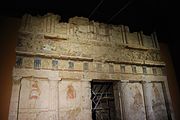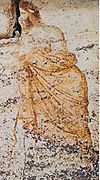Tomb of Judgement, Lefkadia





The Tomb of Judgement (
Description
The tomb consists of two vaulted chambers: an antechamber and a burial chamber and a disproportionately large monumental facade. The structure was covered by an earthen tumulus, which was 1.5 m high and had a diameter of about 10 m; it was removed during excavation.[1][2]
Facade
The facade is 8.68 m wide and 8.6 m high. It once had a triangular
The tomb is best-known for the four paintings in the lower half of the facade. These are located in the upper part of the spaces between the Doric columns. In the outer left space, there is a warrior, depicted frontally, looking slightly to the right. His left hand rests on the sheath of his sword, while his right hand holds a spear point down. He wears a short red
In the spaces to the right of the door, are
Interior
The interior of the structure is made up of two separate barrel-vaulted structures. The antechamber is unusually large: 6.5 m wide, 2.12 m long and 7.7 m high. This is because it is built to match the monumental scale of the facade.[1] The chamber seems to have been unpainted, but it was severely damaged in antiquity and has not been fully excavated.[2] The burial chamber is also barrel-vaulted, but is much smaller, measuring 4.8 m wide, 4.72 m long, and 5.26 m high.[1] The walls are covered in stucco. A white podium with a cornice runs around the base of the wall, supporting white stucco pilasters in low relief, which themselves support an architrave, topped by a cornice. The wall between the pilasters is painted red, and the faux architectural members are decorated with painted rosettes.[1] The design recalls wall painting in houses from the same period that have been excavated in Pella and Delos.[2] The grave goods included a wooden couch with ivory elements, most notably a small sculpture of a woman, which was found in the antechamber.[3]
Excavation
The tomb was discovered during road construction in 1954 and excavated by Photis Petsas from 1954 to 1964. In 1998, it was re-excavated and restored by Liana Stefani. Finds from this excavation are stored in the Archaeological Museum of Veroia.[3] The tomb is protected by a modern structure.[2]
Gallery
References
- ^ ISBN 0-691-03635-7.
- ^ a b c d e f Psarra, I. "Ministry of Culture and Sports: Mieza, the so-called Macedonian Tomb of Judgement". odysseus.culture.gr. Retrieved 14 April 2019.
- ^ ISBN 978-960-9621-09-0.
Bibliography
- Ginouvès, René (1994). Macedonia: From Philip II to the Roman Conquest. Princeton, NJ: Princeton University Press. pp. 178–181. ISBN 0-691-03635-7.
- Πέτσας, Φώτιος Μ. (1966). Ο τάφος των Λευκαδίων. Athens: Αθήναις Αρχαιολογικής Εταιρείας.
- Στεφανή, Λ. (1998). "Η ανασκαφή στον προθάλαμο του Τάφου της Κρίσεως στα Λευκάδια". ΑΕΜΘ. 12: 413-420.
- Στεφανή, Ευαγγελία (2012). "Ελεφάντινα αντικείμενα από τον τάφο της Κρίσεως και οι συμβολικές χρήσεις του ελεφαντόδοντου από την ελίτ / Ivory artefacts of the tomb of Judgement and the symbolic uses of ivory by the "elite"". In Αδάμ-Βελένη, Πολυξένη; Τζαναβάρη, Κατερίνα (eds.). δινήεσσα τιµητικός τόµος για την Κατερίνα Ρωµιοπούλου. Thessaloniki: Αρχαιολγικο μουσειο Θεσσαλονίκη. pp. 509–522. ISBN 978-960-9621-09-0.
External links
- Psarra, I. "Ministry of Culture and Sports: Mieza, the so-called macedonian tomb of Judgement". odysseus.culture.gr. Retrieved 14 April 2019.




